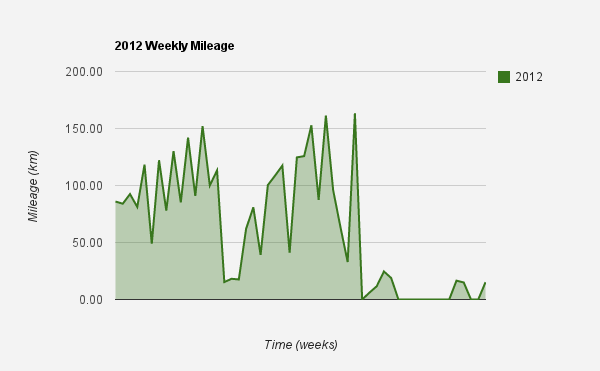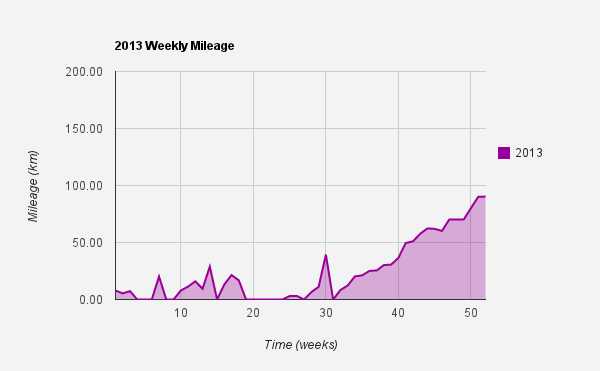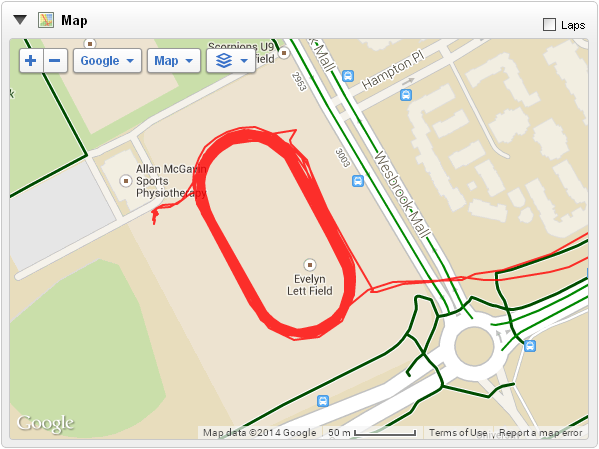I thought I’d review my 2013 in the hopes of helping people devise their own training plans, and just get a sense of what other people are doing.
I took basically an entire year off running, after the Leadville 100 in August 2012. In the summer of 2013 I started running again (my new dog got old enough to jog) and at the end of the year I chose to register for the Hardrock 100. At that point, I really turned it up. I didn’t get in, so signed up for the local Fat Dog 120 instead. So here is my post chronicling my return to “ultra” running.
First of all, let’s take a look at 2012:

Pretty jumpy, but other than that major break around week 16 due to injury, I was running lots, eventually up to 160 km per week. I ran basically 3200 km (~2000 mi) by September. Not bad. (One of my goals had been to hit 5000 km for the year.)
You can see I was following a strategy of alternating longer and shorter weeks, sort of a gradually increasing triangle wave. I was also alternating between doubles, e.g. 34 + 57 km on Sat & Sun, and singles, e.g. 67 km on Sun, for every other “peak” week. So there was very little consistency in my training, other than the fact that I was doing lots of mileage. In the end I was injured pretty seriously, after an 80 km training run. (Some sort of foot pain, Morton’s Neuroma-esque, I concluded.) “Serious” in the sense that I had to take a lot of time off, almost completely.
So in late 2013, when I started running again, I decided to do things slightly differently. First of all, here are my weeks from 2013:

Other than a few weeks of ~ 20 km/week, which was purely dictated by the dogs, I started at 30 km/week in week # 38. I did 3 weeks at each of 30, 50, 60, and 70 km/wk. So roughly 3 months to ramp up to 80 km/week. Then I did 80 x 1, and 90 x 2, then the year was over. I would have done 3 weeks at 80 and 90 as well, but I was impatient and wanted to do 100 km/week for the month of January in 2014! (Plus I had 3 weeks off work so I had way more time to run.)
This approach, holding steady for a few weeks then making a more significant jump, is how Daniels suggests making mileage increases in his book Daniels’ Running Formula. Unlike my previous method, it allows you actually start to feel better at the distance, before moving on. The steady, constant increase method just makes you pretty much always feel bad.
Of course, since I was just getting back into shape, I was always gradually increasing my long run distance, from 20 km to about 42.2 km over the course of the 4 months.
Now, I am into January, and fully into my “steady-state” approach. My weeks are the same for the entire month. This is my current ideal 100 km week: (distances are approximate)
- Sat long run 42.5 km (~ a marathon)
- Sun recovery jog 5k
- Mon AM: recovery jog 6k
- Mon PM: easy 10k
- Tue: off
- Wed AM: recovery or easy 10k
- Wed PM: easy 10k
- Thu: off
- Fri AM: easy 10k
- Fri PM: recovery or moderate 8k
Tuesdays and Thursdays off are dictated by my schedule, not by my training plan. I would much rather run on those days than not, but I don’t have time. So I have to double up my runs on almost all other days. The total for this puts me at about 100 km/wk (60 mpw).
I intend to ramp up to 115 km/wk next month, and so on, up to 160 km/wk. To hit that, I will not increase my long run distance, (well maybe by a couple km, to 45) but instead try to increase primarily the amount I am running on Friday, before the long run. So essentially I start building up towards Friday/Saturday back-to-back high mileage days.
The basis for the design of the training plan can be summarized in a few key points:
- Running more frequently is better
- Shorter runs are safer and easier to recover from (< 25 mi)
- High volume is beneficial
- Quality (speed work) is critical
I am comfortable keeping my long run distance relatively short, because of how Matt Carpenter (Leadville record holder since 2005!) said he trains, as in this article:
I think it is the way people train for [ultras] that makes them slow. I found that I could not do 30-50 mile long runs like most Ultrarunners and still be able to do quality speedwork.
In place of super long runs, I did back to back long runs. Both days I ran faster than I could had I just done one longer run. … All the while I was putting in two quality speed workouts a week—one in the flats and one in the hills.
Unfortunately, I’m still in a phase where I feel like the weekly volume is tough, because of my time off. The marathons every Saturday are still taking quite a lot of effort, and my Achilles are still being problematic. My calves are doing pretty well though! As I adapt a bit better I will start to incorporate some speed work on Wednesdays, and gradually increase the amount of climbing I’m doing on the weekend long runs.
Buzz Burrell wrote:
When a person first becomes involved in trail running, their initial goal is to “run Leadville,” or “do Western States.” Instead of first learning to go fast, they learn how to go long. This is backwards. They may not be able to run effectively, but rather than learning the most primal aspect of our sport, they instead learn how to suffer.
My first race, in May, will be the Elk/Beaver Lakes 100 km, on the island. 100 km sounds like a cool distance to run pretty fast over, and I’m looking forward to it. It’ll be a great test of how the training is going, and I’ll have lots of time to adjust my training plan before Fat Dog.
I’ll be pulling my fast workouts out of Daniels’, as I did for Leadville. Looking forward to getting back on the track!
